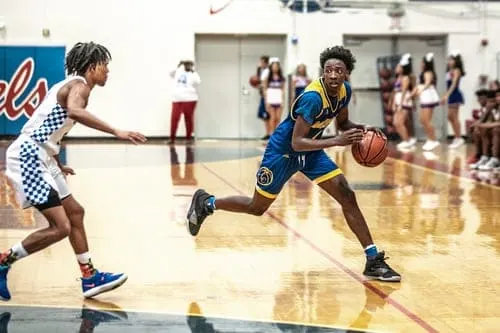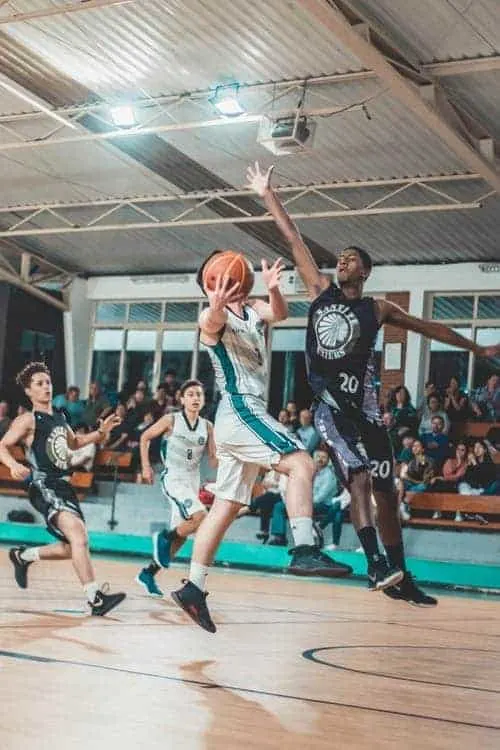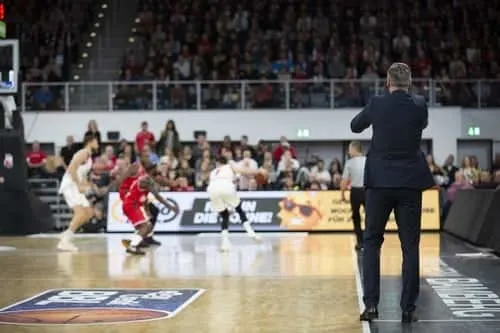My wife always asks me when I’m watching the basketball on tv, “How many minutes are left in the game”, and I’ll say something along the lines of two minutes. She replies with, “so you mean there’s 40 minutes left”. She says that because she has seen teams fouling at the end of a close game and it taking forever for the game to end.
Why do NBA players foul at the end of the game? Basketball teams when trailing at the end of the game will foul because it is a strategic way to stop the clock while allowing the team that is leading to shoot free-throws that are only worth one point hoping that it will result in a miss. The team that is trailing will now take possession of the ball and will try to score to cut the lead. They will repeat this if necessary.
When does a team want to start fouling to gain possession, what is a Hack-A-Shaq? What do you do when your up a couple of baskets or down at the end of a game that is still in reach? All this will be answered and will hopefully help you understand key concepts of basketball situations you will face on a regular basis as a player.
If you are interested in checking out the best basketball equipment and accessories then you can find them by Clicking Here! The link will take you to Amazon.com
What is the point of fouling at the end of the game?
What’s the point? The game is over. Why do they foul? It’s so annoying, just end the game already. Many of these statements we can all relate to and it drives us crazy when there is 20 seconds left on the clock and the team is up 8 and the trailing team fouls. In this case, if you failed to plan, you plan to fail.
The idea of fouling at the end of a game may not be obvious to some, but when a team is behind a couple of baskets with less than a minute and a half left on the clock, it is a strategy that is employed.
The strategy in question is sort of like gambling, you are going to foul and allow the opposing team to get to the free throw line and hope they miss free throws worth one point each. This way you get a chance to come back and score to narrow the lead.
How effective is this?
Well, you really have nothing to lose, if you do nothing then you lose anyways. But if you take a chance and gamble and really it isn’t gambling your stakes are low so to speak, you are giving your team an opportunity to come back and at least tie the game forcing it into overtime, sometimes even winning.
It doesn’t happen often when a team comes back and wins from fouling but it does happen and when it does it is exciting to watch.

The Team Behind with a minute left strategy
A team trailing by a couple of baskets will do one of two things. They will go for an aggressive steal for the ball to get possession even though they know they may foul the player with the ball in the process they are stopping the game clock.
The advantage in going for an aggressive foul is the offense knows your trying to steal the ball, the worse thing that can happen is if you foul and stop the clock it really isn’t all that bad. The best thing that can happen is you foul or create a lot of contact in the process of stealing the ball and get a no-call, which happens often.
So if we steal the ball great, if we foul that’s what we wanted anyway, stopping the clock. The team goes on the free-throw line and we hope they miss so we can regain possession of the ball to come back down and try to score to cut the lead.
We continue to do this many times as needed, hopefully cutting the lead if we make a couple of of three-pointers down the stretch even if the team in the lead makes all their free throws. 3 is always better than 2.

Scenarios to when to foul?
Scenario 1
Team A is down 4 points with 26 seconds on the clock, Team A needs to intentionally foul Team B or Team B can just run out the clock to two seconds which is not enough time to score 2 baskets. Team A hopes Team B misses free throws. Team B makes one out of two and is up 5 points. Team A makes a 3 pointer and Team B is now only up 2 points. Team A must foul again, rinse, and repeat.
Scenario 2
Team A is up 9 points with 52 seconds on the clock, Team B immediately tries to stop the clock by fouling and forcing Team A to make free-throws, If Team A misses one out of two and Team B comes down and shoots a quick 3 pointer, Team A will only be up 7 points with 46 seconds on the clock. They will continue to get a steal while fouling in the process. It has happened where teams have come back and won from such a huge deficit with so little time on the clock.
Scenario 3
What would you do? Team A is up 3 points after shooting two free throws with 7 seconds left on the clock. Team B now has the ball and is looking to score. Does Team A foul or play defense.
Many coaches would not foul some coaches would. This is a difficult question, foul to soon, and risk fouling on a shot or leaving to much time on the clock will force you to make free throws down the stretch. It can go both ways, I say play defense, everyone in the gym knows what type of shot will be taken, play straight up?
Why not intentionally foul the worse free throw shooter?
Great minds think alike unfortunately, fouling away from the ball is an intentional foul and will result in a free throw and possession back to the team that was fouled. This strategy was known as the Hack-A-Shaq rule, in which Shaquille O’Neal was fouled as he was a very poor free-throw shooter. This resulted in missed free-throws and the team would get the ball back to cut the lead.
Shaq attempted 9 free throws for his career and shot 52 percent. When a team is given the odds of one out of two made free throws, they will take that any day to get the ball back and score. The only counter to this strategy is to sub Shaq out completely. The NBA had a problem with this strategy as teams were starting to foul before halftime to cut the lead in half to be in a better position for the second half of the game.
Don Nelson was one of the first to employ this strategy while coaching the Dallas Mavericks.
The team Ahead with a minute left Strategy
The team in the lead benefits from killing the game clock, it comes to the point in the game that letting every second on the clock run out is more valuable than scoring. Because when we attempt to score no shot in the game is a 100 percent guarantee. Time and time again we see missed wide-open dunks or layups with no player around the player.
Now the team ahead when they have wasted enough of the clock, it is now time to shoot the ball. It is best to drive to the basket and try to draw a foul, this is because the defense is already in panic mode playing aggressive defense trying to get the ball back. This is a safe option to go to the basket and draw a foul.
The NBA Vs College Fouling to cut the Lead
In order to even be in a position while trailing to get the ball back by putting the opposing team on the line, the team has to be in bonus. The bonus works differently in the NBA as opposed to NCAA and the number of free throws varies which makes the world of the difference.
NCAA
In college, the bonus happens when a team reaches 7,8, and 9 team fouls, in which they go to the line and shoot what is called a one and one. This means that in order to shoot two free-throws the team has to make their first. If they make their first they shoot another. If they miss their first the ball is live and is available to rebound by either team. This is why when watching the National Tournament, there are a lot of games where teams come back and win due to this format.
When a team reaches 10 fouls this means that they are in double bonus and will shoot 2 free throws no matter if they make or miss their first shot.
Also, keep in mind of a team is not yet in bonus they may need to foul a couple of times just to be in the situation to send them to the free-throw line and try and get the ball back. Sometimes this wastes time trying to foul, so it must be planned when and how you are going to foul.
NBA
The NBA bonus system works differently, fouls are reset every quarter. How it works is when a team reaches 5 fouls they are in the bonus and will always shoot two free throws. Now if a team reaches the last two minutes of the quarter with less than 2 fouls or less, they only need to foul twice in order to put that team on the line. So basically if your team never fouled the whole 4th quarter you only have to foul twice to send the team on the line if you were trailing and trying to get the ball back.
The NBA does this so you are not penalized for not fouling during the game. If you had to foul 5 times in order to allow the team in bonus just so you could get the ball back you would burn a lot of the clock doing so, never having a chance at a comeback.


